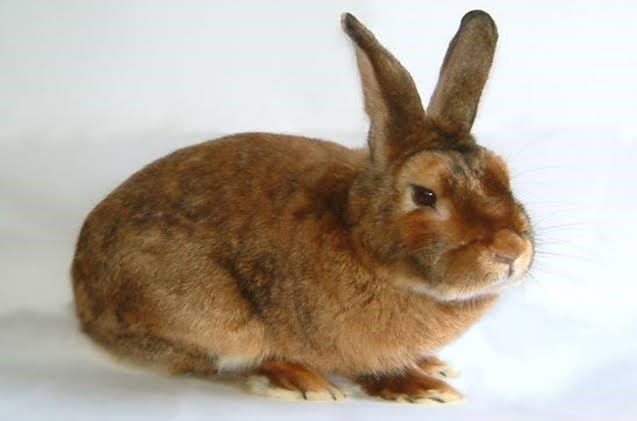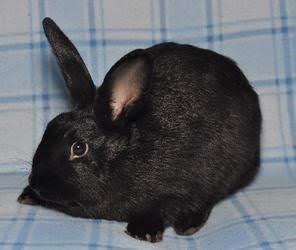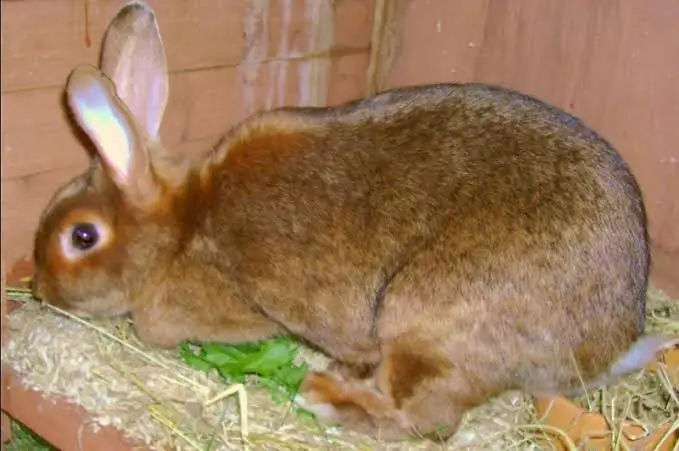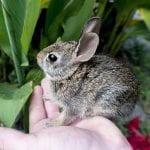Scientific Facts
| Common Name: | Satin Rabbit |
| Scientific Name: | – |
| Life Span: | 7 to 9 years |
| Size: | 8.5 to 11 pounds |
| Habitat: | Domesticated |
| Country of Origin: | USA |
Satin Rabbit Information
The Satin Rabbit actually has an origin story that is quite unique. It is a breed that can trace its roots to the Havana. At first, a certain breeder from Indiana named Walter Huey was trying to find different ways to improve the Havana rabbits he already had with him. What happened was that he was able to breed a different kind of Havana rabbit in a certain litter. The rabbit had a unique appearance, which prompted Huey to send some of those rabbits for testing at Harvard University.
Geneticists at Harvard found out that the rabbit that Walter Huey had was a result of a genetic mutation. It appeared that a recessive gene in the Havana Rabbit was the cause of the entirely different shine and texture of this rabbit’s coat. In that sense, they still regarded this rabbit as a simple mutation of the Havana Rabbit breed.
But when Huey introduced the unique specimen to the rabbit world in comparison to the Havana, experts and other breeders were unable to accept that it was just an ordinary Havana with a mutation. As such, the National Havana Club recognized the rabbit as a variety of Havana called Satin Havana. It then received a sponsorship from the American Association of Havana Breeders for breeders to produce new colors of this unique and new rabbit breed.
As time passed by, the American Association of Havana Breeders began to recognized the Satin Havana as an entirely new breed of its own due to the unique texture and sheen of its coat as compared to the usual Havana rabbit. In 1956, it was then recognized by the American Rabbit Breeders Association as its own breed called the Satin Rabbit instead of as the Satin Havana.
Physical Description

The Satin Rabbit is a medium to large-sized breed that can be quite heavy even though it carries a compact and commercial body type. This breed can weigh somewhere between 8.5 to 11 pounds as a rabbit in its full size. However, these rabbits have a European variety that is smaller and is somewhere close to 8 pounds at maximum size due to different breeding techniques and environmental considerations involved in breeding that variety of Satin Rabbits.
As mentioned, the Satin Rabbit carries a commercial type body that is compact and quite rounded in the places where it is expected to be round. It looks fat and plump because of how round yet smooth its hindquarters are. The back of this rabbit curves quite well and is round and high enough that it can exceed the height of its erected ears when it is sitting flat on the ground. While the Satin Rabbit may be known for being round, it is slightly narrower near its shoulders to give it a shape that is quite reminiscent of a mandolin.
The Satin Rabbit has a head shaped like a wedge but still broad. The ears tend to be erect and are actually considered long and may be as long or even longer than the length of the Satin Rabbit’s head. Meanwhile, regardless of the color of the rabbit, it usually has eyes that are reddish-brown in terms of color.
Its coat is where the Satin Rabbit sets itself apart from all of the other breeds of rabbits. It may have a similar overall appearance and body structure to the Havana, where it was originally bred from, but it has since grown and developed into its own unique breed and has a coat that is very different from that of the usual Havana. The one thing that makes it more unique than most other domesticated rabbits is that its coat has a satin sheen that gives it its name. When you try to stroke its coat, you will notice how smoothly your hand will glide through it like satin silk sheets. It also has that shiny kind of appearance.
The reason why the Satin Rabbit has a coat like this is that the recessive genes of the Havana make its individual hair follicles smaller in diameter compared to most other rabbits. The hairs also have air pockets that catch light that shines on the rabbit to give the Satin Rabbit its unique sheen.
But, even though the Satin Rabbit looks like it needs a lot of grooming because of its unique-looking shiny hair, it actually does not need a lot of maintenance. Other than the usual grooming requirements of any normal domesticated rabbit breeds, the Satin Rabbit does not require you to go all out in terms of how you maintain the sheen and texture of its coat.
The Satin Rabbit used to only have one color. But ever since its breeding was promoted and even sponsored by concerned associations wanting to propagate this breed’s numbers, there are now a lot of different colors for this rabbit. The ARBA officially recognizes black, a combination of white and other colors, chinchilla, chocolate, blue, otter, red, and Siamese, among others as colors for the Satin Rabbit.
Personality

Satin Rabbits have a personality that is almost the same as the Havana or any other domesticated rabbit breed. In that sense, you can expect it to have a demeanor that is overall friendly and very calm and easygoing. It will not be a problem for any owner to have this kind of a rabbit because it is sociable yet not too hyperactive. In comparison to the shy rabbit types that are not used to a domesticated kind of life, the Satin Rabbit has a personality and a demeanor that is well-suited for a life of domestication as it does not mind living under the care of its owner and is not too shy when you try to socialize with it.
Because of its sociable personality, it is important that you spend some time socializing with it. That means that it should not be a pet that you should keep in its enclosure or cage for long periods of time as this rabbit breed requires that you try to spend some time with it outside of its cage. Petting it after taking it out of its enclosure is a good way to socialize with this breed. You can also introduce it to your kids and to other domesticated animals that are safe for your Satin Rabbit to socialize with.
The Satin Rabbit also comes with a really great docile personality that pet owners love from their pets. They are not fussy when you try to handle and pet them and are usually very submissive in the best of ways when you socialize with it. As such, this is a great first-time pet for a lot of different owners who are yet to learn how to handle and socialize with pets that are a bit tougher to handle than the calm and
Friendly and generally good-natured, the Satin Rabbit can be sweet and very happy to be with because of its kind personality. You will not have any trouble befriending a Satin Rabbit even if you are just a mere guest visiting your friend’s house and interacting with the rabbit for the first time. As long as you approach it well enough for it to feel like you are not a threat, you can expect that his rabbit will not be too shy to be around you. However, the most important part is for owners to have these rabbits used to a life of socialization ever since their younger days, or else, it might be a bit more difficult for anyone to socialize and interact with this breed.
Life Span
The Satin Rabbit is not the most resilient breed as it does not always get to live as long as some other breeds do. Nevertheless, it can be expected for this rabbit to have a lifespan that is similar to a lot of other domesticated breeds in the sense that it can get to live for at least 5 years when given with the minimum care required for it to thrive well. However, most of these rabbits can actually live a minimum of about 7 years with reasonable care.
At the maximum and when they are treated in the best way possible under the best kind of conditions for this rabbit breed, the Satin Rabbit can possibly live for about 9 years but may not live for a decade or more, unlike some other rabbit breeds do. You may be lucky enough, or you might be the best kind of owner if your Satin Rabbit can get to live for more than the usual 7 to 9-year lifespan.
In terms of its overall health, the Satin Rabbit really is not one you could say that is susceptible to a lot of different illnesses and conditions that can possibly affect its lifespan. It will not have a lot of health problems, but that does not mean that you should just leave it be. Preventive measures that make it much more resilient against illnesses and parasites should be taken to make sure that you do not have to spend a lot of money for treatments later. To that end, providing a vitamin D supplement to your Satin Rabbit is essential because it is normal for most indoor rabbits to develop vitamin D deficiency due to how they lack exposure to the sunlight. You should also regularly visit the vet to have its ears cleaned and to make sure that it is as free from mites as possible.
Reproduction
The Satin Rabbit generally follows the same reproductive behavior as any domesticated breed of rabbit. It will most likely be ready for breeding at sexual maturity, which is somewhere between 4 to 6 months old. These rabbits have the capacity to give birth multiple times in a single year because of how short their gestation period tends to be. Of course, like most other mammals, they can give birth to a litter size that has about 2 to 6 rabbits.
Behavior
If there was one thing common between the Satin Rabbit and the Havana Rabbit and a lot of other domesticated breeds of rabbits, it is that this breed is generally a well-behaved and good-natured rabbit that will not cause a lot of trouble for you and your family. The calm personality that they carry allows them to behave well in almost any kind of situation as these rabbits almost do not misbehave in any sort of way that can make them too difficult to handle. They are not hyperactive or too curious to the point that they will make you chase them around the house.
Since the Satin Rabbit is a breed that is not very difficult to take care of as far as its overall behavior is concerned, they are excellent pets to have for young and old owners alike. Even children will find them quite easy to control due to how they are generally friendly towards kids and are not very fragile or easily agitated. In the same way, first-time pet owners will find them a joy to take care of as they are well-behaved enough and are simple pets to have for any kind of owner.
The Satin Rabbit, when socialized at an early age, is not only friendly towards humans and domesticated pets alike but is also very fond of interacting with anyone or anything it deems as friendly and harmful creatures. They are easy to socialize with for kids, and older adults alike and are not too troublesome or difficult to interact with for any kind of pet owner or friend of the owner.
While it is not the most playful breed of rabbit, the Satin Rabbit might display its playful side if it has gotten used to living a life of constant interactions. It will not be too surprising for it to show its playful personality if you try to play with it using toys after letting it loose from its cage. And speaking of its cage, having it spend time outside its enclosure is not only a good way for it to stretch its legs but is also one of the best ways for you to promote its sociable side. Satin Rabbits that have been socialized well since their younger days will be quick to try to cuddle up or stay close to its owner the moment that they are allowed some time outdoors.
The Satin Rabbit breed may be susceptible to litter training by using the same type of litter box that cats use. However, they are not as easily trained as cats are. But the best way of litter training them is by placing multiple litter boxes all over the room to make sure that they will know where they need to do their duty when nature calls.
Eating Habits
Satin Rabbits seem like they need a special kind of diet to make sure that they retain the usual sheen and texture their unique coats have. However, that is anything but true as this rabbit can actually thrive pretty well when following the usual diet that most other domesticated breeds of rabbits follow. Just imagine it as a Havana Rabbit with a type of coat that looks a bit more unique.
In that sense, the Satin Rabbit should be fed with a diet that is 70% hay, which is rich in fiber and difficult to chew. Any type of rabbit needs to have a high intake of fiber to help them with their digestion problems. Moreover, since a rabbit’s teeth never stop growing, allowing them to chew on hay minimizes the possibility that their teeth will overgrow. Hay should always be the Satin Rabbit’s primary source of nutrients.
The remaining 30% of your rabbit’s usual calorie intake should be made up of a combination of leafy greens, vegetables, fruits, and rabbit pellets that can be commercially bought from pet stores. Always keep an eye on the type of greens and vegetables you give your rabbit because some of them might be harmful to your pet’s health. Also, try to avoid giving your rabbit vegetables and fruits that are rich in sugars as these pets are not well-suited to digest large amounts of sugar. Try to stay on the low side of things and treat high-sugar vegetables and fruits as occasional treats for your Satin Rabbit.
Water
While Satin Rabbits are not very active in the sense that they will easily tire out, they still need to consistently rehydrate. Always keep a water dish close by or in their cage so that they can take a sip of water whenever they want to. Keep an eye on the water to see to it that it is clean and fresh. Always replace their water on a regular basis to minimize any kind of water-borne disease or parasite. You can also place a smaller water dish to minimize the possibility of it tilting and getting your rabbit wet. Any kind of domesticated rabbit does not like getting wet as they easily get stressed when that happens.
Cage

When housing a Satin Rabbit, you can have a choice of housing it either outdoors or indoors because this rabbit is well-adjusted to living in many different types of conditions. It really depends on your preference and on the environment you live in.
When housing your Satin Rabbit outdoors, the first thing you need to consider is the type of environment you live in. make sure that the outdoors is free of any kind of predator and that the climate is suitable enough for it. The best part of keeping your pet rabbit outdoors in a simple enclosure made out of wood and wire is that it can get a lot of sunlight and has more than enough room to stretch its legs. However, it will be much more susceptible to outdoor diseases and parasites.
Housing the Satin Rabbit indoors might be the best choice for you if you want to make sure that it stays in an environment that is safe enough for it. Keep it in a cage that is at least five times its size. The difficulty in doing so is that the Satin Rabbit can be on the larger side of things, and it might be a bit hard for you to find a rabbit cage that is big enough to fit it. Nevertheless, the most important part here is to make sure that the cage has enough room for the rabbit to move around and stretch its legs. And speaking of its legs, choose a cage that does not have a wired flooring because this can cause injury to your rabbit.
Keeping toys in the Satin Rabbit’s enclosure is not essential because it is not the most playful breed. If you want it to play, it is better to have it do so outside of its cage instead of inside. Keep the inside as free of any kind of furnishings as possible to give the rabbit the room it needs to feel free to move around as much as it wants.
Availability – Where to Get one?
Satin Rabbits are recognized by the ARBA and are some of the most common rabbits to find in the entire American continent. These rabbits can be found in a lot of different websites. A simple search on the internet will reveal several results. If you want to secure one, a Satin Rabbit from a reputable owner can cost somewhere between $50 to $100 depending on the color and on the breeder. Try not to go for a price that is drastically lower than $50 as the quality and the purity of the rabbit might come into question. Always go for Satin Rabbits that follow the standards set by the ARBA.
How to Care for a Satin Rabbit?
Satin Rabbits really are not the most difficult rabbit to take care of. They are generally very easy to master as pets because they generally follow the same kinds of health and care requirements as most other breeds of domesticated rabbits. The Satin Rabbit is actually just an offshoot of the Havana Rabbit and should be given the same kind of care as any other domesticated breed.
While you may think that the Satin Rabbit needs a special kind of grooming requirement because of how unique its coat is in terms of its sheen and texture, it actually is quite the opposite. Even though it has a beautiful coat, it does not need to be groomed in a special or unique kind of way and can easily retain its sheen and texture when grooming in a similar way to any domesticated breed of rabbit.
Another thing to take note of here is that the Satin Rabbit can be a bit prone to obesity because of its large and compact body type. In that case, you need to keep it on a strict diet. Make sure to never overfeed this rabbit as it can easily get fat due to its natural plump body type and how it is not the most active breed of rabbit. If possible, try to watch portion sizes and always see to it that it follows a diet that is high in fiber to minimize the risk of it getting too fat for its own good.
FAQs
Are Satin Rabbits ideal pets?
The Satin Rabbit is an ideal pet to have because of its generally good-natured personality and its calm and easygoing demeanor?
Are Satin Rabbits active pets?
Sati Rabbits are not the most active pets and do not spend a lot of time walking and playing around.
For what purpose was the Satin Rabbit bred for?
The Satin Rabbit was originally a result of a mutation of the Havana but has since been purposely bred to become a breed of its own.
Are Satin Rabbits friendly towards children?
Satin Rabbits are generally friendly types of rabbits that can interact and socialize well with children and adults alike, regardless of their age and experience level with pets.
Do Satin Rabbits like getting handled?
Satin Rabbits are easy to interact with and are very receptive to getting handled by different types of pet owners so long as they approach it in a friendly manner.
How should I interact with my Satin Rabbit?
A socialized Satin Rabbit is quite easy to interact with. You can just take it out of its cage, allow it to stretch its legs outside of the enclosure, and handle and cuddle it in a safe and calm manner so as to make sure it feels secured being around you.
Is the Satin Rabbit recognized by the ARBA?
The Satin Rabbit used to be a mere variety of the Havana but eventually gained recognition as its own unique breed during the 1950s.

